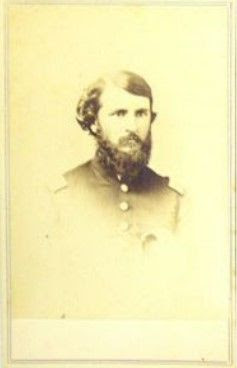The enemy is no more here: Willich’s Reconnaissance to Rigg’s Crossroads
Sunday December 28, 1862, found Rosecrans’ army spread out across middle Tennessee. Crittenden’s corps and Negley’s division of Thomas’s corps held positions along the north bank of Stewart’s Creek near Nashville Pike while the three divisions of General Alexander McCook’s wing lay in camps near Triune. Rosecrans directed that the bulk of the army remain in camp for the day to observe the Sabbath, however all was not quiet within the army.
The key question that Rosecrans and
his staff grappled with was determining what direction Hardee’s corps had
marched on the 27th. Had they marched east to Murfreesboro, or south
to Shelbyville? “If he had retired to Shelbyville, it indicated the withdrawal
of Bragg’s army from Murfreesboro,” William D. Bickham of Rosecrans’ staff wrote.
“If he had merely fallen back to Murfreesboro, it justified the conclusion that
the enemy had determined to meet us in a general engagement in that vicinity.”
The task of determining this normally
would have fallen to the cavalry, but the army was so short of troopers that
the assignment went to General August Willich’s brigade of Johnson’s division.
McCook’s orders to Willich were to march south along the Nolensville Pike to
Rigg’s Crossroads and find out where Hardee had gone. The green 2nd
Tennessee Cavalry was pulled from the cavalry reserve to accompany this reconnaissance
while the German 32nd Indiana led the infantry column.
Captain Horace Fisher, serving as acting
assistant volunteer aide-de-camp and topographical officer on McCook’s staff, rode
along. A Massachusetts volunteer (unusual in the Army of the Cumberland), the
Harvard-trained (class of 1857) attorney proffered his services to General Don Carlos
Buell in early 1862 but soon fell into McCook’s military orbit and became a
trusted member of his staff, serving until November 1863 when he resigned his
commission due to wounds sustained at Chickamauga.
“McCook
ordered me to take Willich’s brigade and the cavalry and ‘find out where Hardee
had gone,” Fisher later wrote. I took with men some 20 men from our escort for
couriers and orderlies and a dozen spare horses. My first move was to secure
guides. I commandeered a dozen farmers and mounted them on spare horses. I then
told them that there was “just one thing that they all could agree upon-the
truth. I gave them fair warning that if they led us into any trap, the orderly
alongside of each one had orders to shoot him on the spot, but that if they did
their duty, they would be taken back to their homes safe and sound. Otherwise,
they would be left dead on the roadside. You never saw a dozen men more anxious
than those men to tell of every path, trail, or lane near our line of march.”
“Meanwhile I sent the rest of my escort men scouting to pick up stragglers of the enemy knowing that on a night march, men are bound to fall out or straggle,” Fisher continued. “In this way, we corralled a score of Confederate stragglers who were brought to me for examination. My first question, notebook in hand, was their name, regiment, and brigade. My next step was to examine their haversacks to see how much food they had. When I found they had one day’s cooked rations, I asked, ‘When did you have orders for cooked rations for one day?’ They substantially agreed that the order was issued about 9 o’clock Saturday night and that they marched at midnight."
 |
| General August Willich with his pet raccoon perched upon his shoulder receives a report from an orderly. |
"Of course, they did not know where they were going on that night march, but their haversacks told me. It was 26 miles from Triune to Shelbyville. Therefore, they were not going to Shelbyville as we generally thought up to that time. But it was only 15 miles to Murfreesboro and, therefore, only one day’s march. I had found out for what I had been sent. But I realized that Hardee, by starting about midnight, could reach Bragg’s main army that day unless he could be delayed and that, if he did, Bragg would be able to attack our army the next morning while McCook’s third of our army was a long day’s march away and unable to assist,” Fisher wote.
What Fisher decided to do was to try a ruse; he had Willich’s
men go into camp, making fires and coffee. Once the fires were going and making
lots of smoke, the brigade formed into column on the road, countermarched 200
yards then repeated the operation. And then did so again. “In this way I sought
to indicate by the smoke of three brigade campfires that we had a whole
division taking their noonday meal preparatory to continuing their march in pursuit
of Hardee’s corps,” Fisher explained.
Whether the ruse worked or not is open to question. Hardee’s corps marched into Murfreesboro on the 28th and soon took position on the left of Bragg’s army. Cavalry detachments explored the Shelbyville Pike south from Rigg’s Crossroads but could find no signs of Hardee, reinforcing the contention that he had marched to Murfreesboro. General Willich accordingly sent a dispatch to McCook around noon that simply stated, “The enemy is no more here; all gone to Murfreesboro.” McCook passed the news along to Rosecrans. It was now clear- Bragg intended to fight at Murfreesboro. The die was cast.
To learn more about the Stones River campaign, be sure to check out my new book "Hell by the Acre: A Narrative History of the Stones River Campaign" available now from Savas Beatie.
Source:
Fisher,
Horace Cecil. A Staff Officer’s Story: The Personal Experiences of Horace
Newton Fisher in the Civil War. Boston: Thomas Todd Co., 1960, pgs. 51-52












Comments
Post a Comment